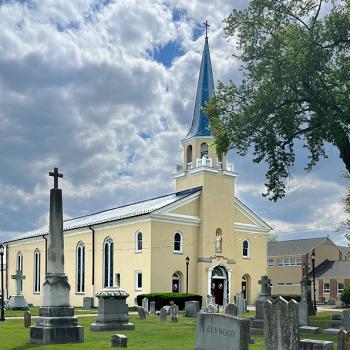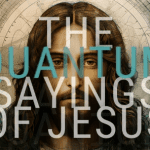As we learned more about the Society of Friends, I began to see why it had been so influential in the formation of the culture of the United States.

In 1693 William Penn gave the property, now in the prime section of downtown Philadelphia, to the Society of Friends, known as Quakers. The meeting house was built later. Betsy Ross, that intrepid upholsterer who performed the renegade act of creating the first American flag, worshiped here. And I worshiped in that same meeting house Sunday, Nov. 9, 2014.
We crossed the flag-stoned, high-walled courtyard and burial ground to reach the simple red brick building, its worn white door opening by an old-fashioned hinge lock. The greeter explained where the worship would take place and welcomed us into a large parlor where coffee, tea and other refreshments sat freely available. About 15 people stood or sat in quiet conversation.
We wandered around, looking at artifacts and literature. A gentleman approached us saying, “I know you are visiting today. May I show you an historical part of the building before worship begins?”
Readily agreeing, we followed him to a large, wooden double door. We walked down a few stairs, and entered the original 1804 worship space. The large rectangular room could hold over 1000 if packed in tightly.
A balcony surrounded three sides. Our guide explained that the youth sat there, chaperoned by adults holding long poles which would be used to tap inattentive or talkative youth on the heads.
At the front of the room were a set of “facing benches,” i.e., benches slightly elevated from the rest of the room. Generally, those designated as elders and ministers sat there although there are no formal set-apart clergy among the Quakers. In this particular room, a curved panel extended over the facing bench–an early sound board that permitted those speaking to be better heard.
It was at the facing bench where young people who were choosing to commit themselves to each other in marriage would go to exchange their vows. Although this would be done without the help of any ordained clergy, it was a time happily celebrated by the Society of Friends.
We also learned that a Quaker worship house is not built to last forever. It and the furniture are built to be used, and then to be reused or destroyed.
At 10:30, we walked into the room that serves now as their worship center, for the congregation can no longer fill that large room. Aged wooden and cushioned benches lined all four sides of the unadorned room. Nothing on the walls, windows uncurtained. Worn industrial carpeting covered the floors.
No elevated benches here; people sat where they wished. Quaker worship begins when the first person enters that room. All others then enter in silence and take their seats.
About 60 people joined us in time. For 25 minutes, we sat in silence with one another. Most people had their eyes closed, focusing on centering themselves on the inner light. A few slept lightly. Peacefulness permeated.
Anyone may speak at any time. However, they are to ask themselves if the message that they are receiving is for the public or just for themselves. When someone does speak, it is expected that there will be silence in the room afterwards. The message is never answered by someone else. There is no argument, no discussion. It simply stands as it is.
Periodically, the entire time of worship will be spent in silence. On this particular day, four people had a message, each one speaking five minutes or less. It was explained to us before we went in that we would know when worship was over when two people stood up and shook hands. After approximately an hour, exactly that happened. Just before that moment, I was aware that something had changed in the room. The deep and quiet peace that permeated the space had changed to something that was now open to conversation.
Several announcements followed and then those who were visiting or anyone else who wished to were invited to introduce themselves. We did so, and then the meeting was dismissed. Several people came up to talk to us and we had opportunity to learn more about the history of Quakerism.
As we learned more about the Society of Friends, I began to see why it had been so influential in the formation of the culture of the United States.
Some of the main principles they stand for:
- What is right; not what is expedient.
- Courage and conviction not to seek submission to incipient evil.
- Peace and brotherhood among nations; not war and preparations for war.
- Good taste and simplicity; not dead conformity and display.
- Fair and honest dealings; not injustice and avarice.
- Broad cultured minds; not selfish intellectualism and coldness.
- Wise aid to those in need; not demoralizing charity.
- Inward revelation of truth; not dogmatic theology.
Our summary comment, “I felt as though I had just taken a refreshing dip in a cool spring on a warm day.”
Additional Thoughts: An Issue of Trust
A primary principle of worship in the Society of Friends: when someone has a message, the rest of the community receives that message as true to that person. It is just to be heard, not argued with or even answered. It may not be true for anyone else in the worship service, but it is to be trusted as a revelation given by God to a person formed by the spiritual disciplines integrated into the lives of those who have committed themselves to the Society of Friends.
Because they are not doctrinal in orientation (i.e.,one can be Buddhist or Jewish or Christian AND be a member of the Society of Friends), those kinds of boundaries don’t define what is true or not. But other boundaries do, and I’ve listed some of them above. They are a deeply ethical people and their guidelines insist on much personal maturity and self-responsibility for thoughts and actions.
Essentially, they trust one another to hear the voice of God, EVEN if the revelations of others are different from one’s own personal beliefs and revelations. That is why the speakers are just received, not greeted with a list of those who would speak for or against what was just said. Again, it is trust, deep, profound trust.
Now, to those who are United Methodists who read this blog: consider with me the difference between this and what we have seen in recent years that passes for “holy conferencing.”
In the UMC, those who are like-minded in various disputed issues meet behind closed doors, create statements that are often anonymous in authorship, float them through various media outlets, wait for the inevitable backlash and then seek to discredit or expel their opponents.
Proposals are carefully crafted to come before the various committees at General Conference, fought over, and narrowed and honed in those committees. Some actually reach the floor of the General Conference. Opponents to the various proposals have their arguments prepared, and hope, with those logical arguments, to destroy the basis for their opponents’ proposals.
Our “holy conferencing” is almost totally adversarial in nature, unless one is with those who only agree with the issue on the table.
Listening, trusting, and believing that God is speaking to all of us are not components of our conferencing. We are out to win–and when one side wins, they seek to defeat thoroughly, even to the point of expelling from our covenant connection, those with whom we are in opposition.
And we have the temerity to call this ultimately destructive process “holy.”
What if we actually trusted one another WHEN, not if, we differ?
What if we could trust that God is working in and among us, we who have worked hard to bring our minds, souls, bodies and spirits into the mold of Christ-likeness, DESPITE our differences?
What if we could trust one another in our differences as we work to define the nature and grace of God, salvation, sanctification and social principles within our distinctively United Methodist ways that are as consistent as possible with our Articles of Religion and Wesley’s Sermon’s and Explanatory Notes? I write “as consistent as possible” because, again, each of us will define “consistency” different. That is the glory of our humanness–we have individual minds, creative processes, experiences and educations, making doctrinal differences not just possible but inevitable.
What if we could see the power in those differences, so that they enrich us, rather than impoverish us?
What if we could just trust?
What if we did not feel the need to immediately form a counter-argument to each proposition with which we differ, but could trust that is it right for that one, again under the general umbrella of the UM world?
What if we could simply let statements stand, and be held together because we do believe that God is indeed working in us, rather than condemning to eternal separation those with whom we differ?
Yes, This Is Complicated
I know this is a complicated thing to do. Distrust comes much easier than trust. Our litigious nation, built on taking apart the jot and tittle of every law, every proposition, every ordinance, has produced the opposite of a culture of trust.
But we are the church–we are supposed to be operating on a different level.
We, as United Methodists, are formed by the means of grace, which includes the holy conference. Such conferencing is NOT debate, it is not “Three arguments for and three arguments against” followed by a vote with its inevitable winners and losers.
We are called to be one people, held together as we become the mind of Christ for the people of our worlds.
This has never been an easy process. It never will be. I’ve been doing a great deal of reading recently about the formation of the Nicene Creed and the challenges of agreement facing the Church Fathers–who made sure that the Church Mothers were unheard in that discussion. Things have not changed in that regard. But we can and should be doing it better than we are right now.
Here is a reasonably complete list of the various proposals to reform/split the UMC and their possibilities of actually passing. I appreciate all the work that has gone into trying to re-thinks and re-create the structure of the UMC. None will actually work, however, until we learn to honor and trust one another on a far deeper level we do now. Only then can we find unity that does not demand unanimity–and which opens the doors to real grace.
















